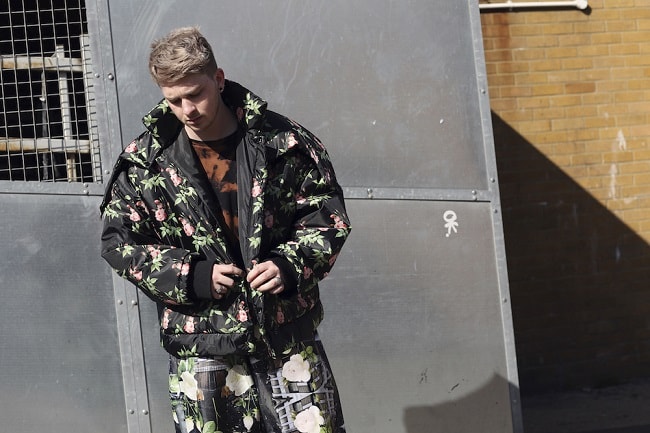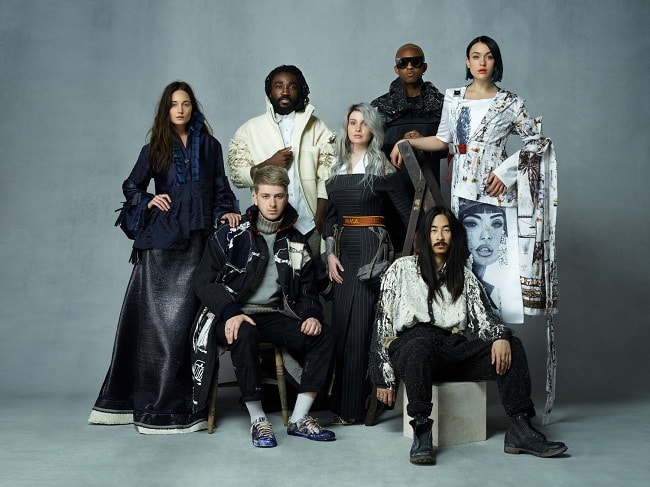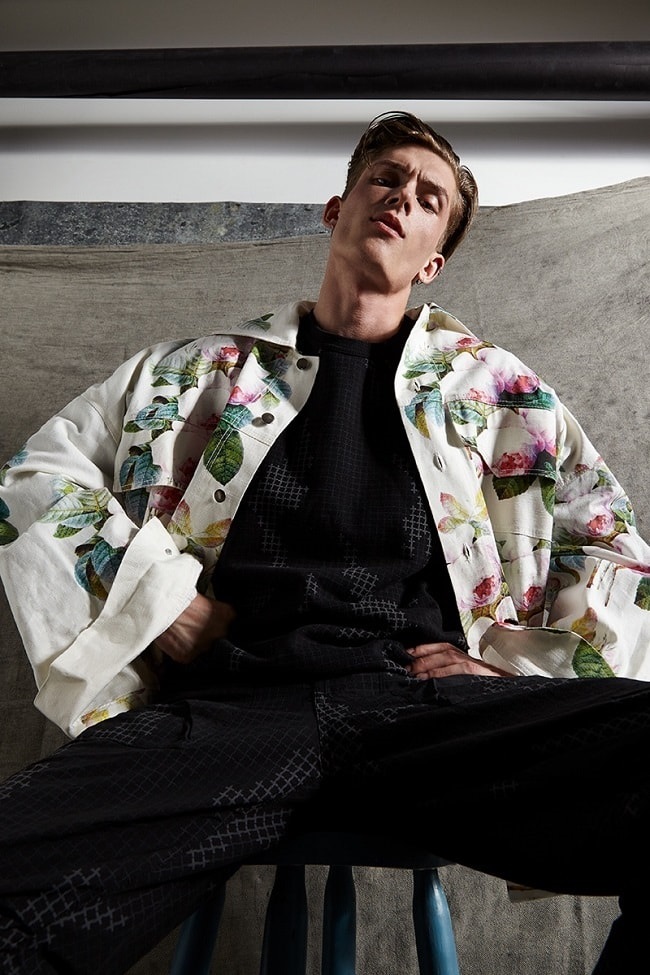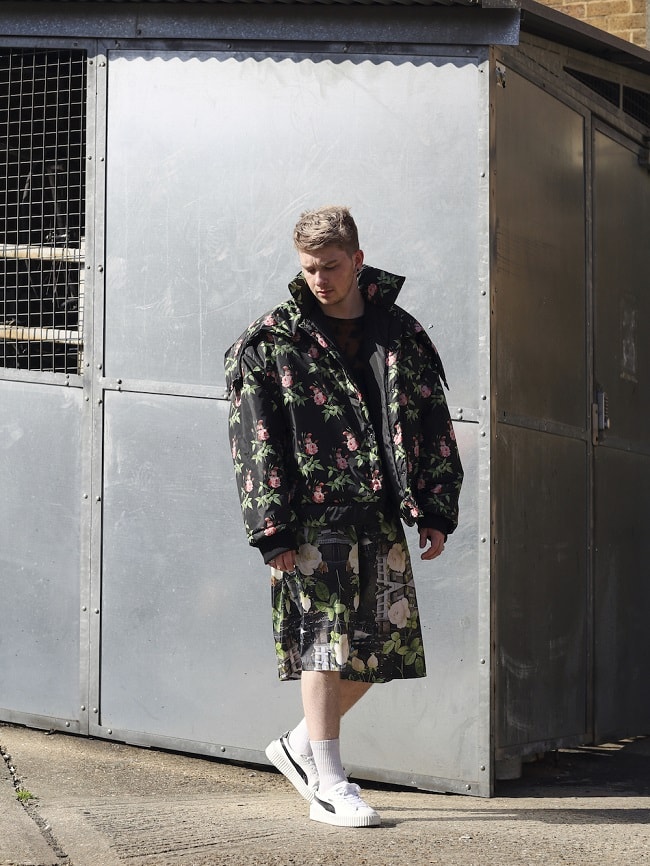1
HOME > Interviews >
INTERVIEW WITH MENSWEAR DESIGNER JAMIE BACKSHALL
FROM NOT KNOWING HOW TO THREAD A MACHINE TO BEING TIPPED AS THE TALENT OF TOMORROW
Written by Ivan Yaskey in Interviews on the 13th February 2018

While many point to London Fashion Week’s MAN project as the spot to identify emerging talent, Graduate Fashion Week acts as another barometer. Its far lengthier history encompasses Christopher Bailey as a prize winner and has helped launch the careers of Stella McCartney and Giles Deacon. Based on last June’s presentations, there’s another name you’ve got to watch out for: Jamie Backshall. The 23-year-old, originally from Croydon in South London, studied at UCA Epsom and had his work selected for Graduate Fashion Week’s Talent of Tomorrow campaign, a pre-show effort to highlight the event’s student designers. That latter project got him featured in Vogue and, just as important, introduced his style to a larger audience.
In recent years, both menswear and unisex fashion have looked toward androgyny in varying degrees. At points, some might say the vision goes too far: For instance, a menswear collection based entirely around skirts and sheer materials, as NICOPANDA essentially did with its 2015 introduction.

Backshall, rather, squarely – and intentionally – points at the centre. For his GFW presentation; spacious, draped, yet still angular silhouettes borrow from London subculture, streetwear, and boxing. The prints and materials – high-contrast, pink-infused florals and matching fuzzy fur – mark a sharp detour into traditional feminine territory. Added to all this, camouflage patterns and workwear hints toward the latest streetwear trends. Since last year’s GFW, Backshall has had his pieces featured in The Fashionisto, Mixmag, Candid Magazine, and the first edition of Wave Mag. As he puts together his first post-graduate collection under his own brand, we had a chance to speak with him about his background, last year’s presentation, and future plans.

Tell me about your background and what got you into fashion?
“I’ve always been into my clothes, and I feel, growing up, I used that as a way of expressing myself. Then, when I started working for Urban Outfitters at 16, all my friends working there were older and studying fashion design and inspired me to get into design. That’s when I felt I could properly express myself, by designing my own clothes. That’s when I decided to do a foundation course in fashion and textiles, and then went on to do a BA in Fashion Design. I’ve been lucky enough since graduation to come straight into the industry whilst getting my final collection featured in various magazines and music videos. Growing up and to the present day, I box. A lot of people feel this is a weird contrast, but to me, it goes hand in hand. A lot of my silhouettes are taken from these very butch, masculine elements. Not just for design but in regards to relieving stress from my career, boxing allows me to do this.”

Why did you decide to study at UCA Epsom?
“I decided to study at UCA Epsom because I had a couple of friends who were there when I was at school who said they loved it there. Also, my film teacher from A levels had a close friend there, and he strongly recommended and thought that I would succeed there. I went to an open day, along with a few other Universities around London. I knew this was where I wanted to start my journey.”
For your GFW presentation, what influenced your collection?
“The main inspiration for my graduate collection was based on my favourite Tupac Shakur song, 'The Rose That Grew From Concrete,' and then I dissected this poem to get inspiration for silhouette, print, colour, and garment construction. Firstly, the silhouette came from one of my favourite photographers Jamel Shabazz, who photographed NYC in the 1980s. Then, my colour and print story came from an artist called Pierre-Joseph Redoute, who paints beautiful roses, which I combined with the gritty photography of Camilo Jose Vergara, who photographed the Bronx in the early ‘70s. This allowed me to produce a real-life contrast between the masculinity, through the silhouette and the inspiration from the Bronx, and then the roses added femininity. And, finally for my garment construction, I wanted to create garments that portrayed the rose growing from the concrete, so I looked at architect Gordon Matta Clark’s work, where he drilled gigantic holes of different shapes and sizes in buildings to create perspective. I took this forward into my garment construction.”

What was your approach to putting together your final collection? How did that change from your pre-collection?
“For my pre-collection, I didn't really consider picking a topic that meant a lot to me. Whereas, with my final collection, I made sure that at the end of it, you could tell it was the work of me.”
How did it feel to have your work featured in GFW’s Talent of Tomorrow campaign?
“I was extremely gassed (which means excited). Coming from first year where I didn’t know how to thread a machine to having my work featured in Vogue was a pretty surreal moment for me. I still have to pinch myself now when I see it.”

What’s your plan to follow up your GFW presentation? Can we expect a full collection?
“Most definitely; that will be the next step. I’m currently working on my next collection, which I’m really getting my teeth stuck into, and I'm aiming at potentially some time this year to have a catwalk show.”
Your Instagram page mentions you are the accessories assistant designer for Dr. Martens. How do you balance working for one brand and starting up your own menswear line?
“Yeah, I’ve recently started this job. I've been there a month now, and absolutely love it. In regards to balancing work, any spare moment in the day and when I get home from work, I spend on developing my new collection and label - which, for me - the end goal is to have a successful menswear brand.”

Trending
2
3
4
5
6
7
8
9
10










